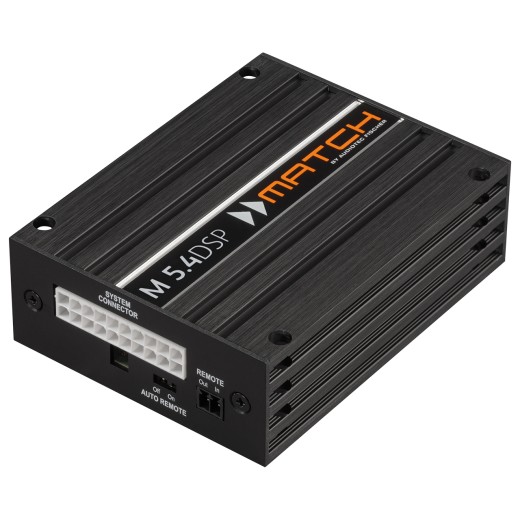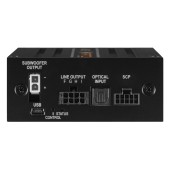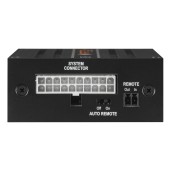Amplifier with DSP Match M 5.4DSP
More about the product
- You can return the goods to us within 14 days
Amplifier with DSP Match M 5.4DSP
Barely bigger than a smartphone, but big on features and performance! This new, 5-channel amplifier offers the brand's latest technology, including state-of-the-art features. Thanks to the M 5.4DSP, it is thus possible to perform installations that were previously unthinkable. You can hide this little miracle anywhere, even in the smallest cars. Installations are then literally invisible.
Ultra compact installation
In modern vehicles, the space available for sound enhancement is increasingly limited and presents new challenges for fitters. Thanks to its minimal dimensions, the M 5.4DSP can be mounted even in the most difficult spatial conditions and opens up new, unimagined possibilities in the choice of installation location. In addition, the all-new Smart Control Port (SCP) offers a significantly more space-saving connection thanks to an extremely compact and securely lockable connector. All Audiotec Fischer remote controls - such as the CONDUCTOR or URC.3 - can be connected through the SCP and easily placed in even the smallest installation positions. In addition, the new Smart Control Port (SCP) offers a significantly more space-saving connection thanks to an extremely compact, securely lockable connector. It is also possible to power the controller directly via the SCP, which eliminates the need for an additional power cable and simplifies installation even more.
Performance and true Plug & Play on demand
The M 5.4DSP offers two power modes that allow it to operate in either "HighPower" mode for maximum power or "MidPower" mode with reduced output power and lower power consumption for Plug & Play applications without a separate power cable. The MATCH range of accessories offers a large number of pre-assembled adapter cables for simple plug & play connection - and is therefore 100% upgradeable without leaving any traces.
Maximum flexibility
The extremely powerful 64-bit audio signal processor offers nine DSP channels. Four freely configurable RCA outputs allow the connection of additional amplifiers, such as the MATCH M 2.1AMP amplifier. This enables complex and space-saving multi-channel systems with enormous performance.
Virtual Channel Processing - a new era of signal routing
In order to handle the multitude of DSP channels and configure them in a user-friendly way, the M 5.4DSP is equipped with Audiotec Fischer's innovative virtual channel processing. Modern factory sound systems with an increasing number of inputs have a significant effect on the complexity of the signal routing inside the amplifier. Especially when several input signals are first mixed and then split again into multipath systems, conventional routing concepts quickly reach their limits. Thanks to Audiotec Fischer's new multi-stage "Virtual Channel Processing", combined with the familiar and user-friendly DSP PC-Tool software, even very complex system configurations look easy. In addition, it allows you to freely assign our proprietary sound FX functions such as "RealCenter" or "Augmented Bass Processing".
ACO - advanced 32-bit coprocessor platform
The M 5.4DSP features an extremely powerful 32-bit ACO platform. It takes care of all control tasks and is faster than traditional systems, especially in data communication with our DSP PC-Tool software. The ACO platform even introduces lightning-fast switching between up to 10 sound settings. But ACO offers much more - fantastic sound effects such as Augmented Bass Processing or RealCenter are easy ways to maximize the sound experience. Additionally, a channel-separated input equalizer including an Input Signal Analyzer (ISA) enables easy analysis and compensation of input signals provided by modern radios and head units.
GD class technology
Audiotec Fischer's proprietary Class GD concept takes the efficiency of conventional Class D amplifiers to the next level. By changing the internal supply voltage in several steps depending on the input signals of the amplifier, the idle losses are greatly reduced and the overall efficiency is always close to the maximum. So heat dissipation is almost negligible, allowing for the smallest coolers and the most compact shapes.
Start-Stop capability
The MATCH M 5.4DSP switching power supply ensures a constant internal supply voltage even if the battery voltage drops to 6V while the engine is cranking.
Two power options
The M 5.4DSP has two power modes - "HighPower" mode for maximum power and "MidPower" mode with reduced output power and lower power consumption for Plug & Play applications.
Intelligent high-level input ADEP.3
Modern, factory-installed car stereos include sophisticated diagnostic options for connected speakers. Especially the latest generation of car radios are equipped with additional monitoring functions, so when connecting a regular amplifier, error messages and loss of specific functions (eg fader function) appear quite often, but not with the M 5.4DSP. The new ADEP.3 (Advanced Diagnostics Error Protection, 3rd Generation) circuit avoids all these problems without unnecessarily loading the OE radio's speaker outputs at high volume.
RealCenter
The "RealCenter" function is Audiotec Fischer's proprietary algorithm that emphasizes the monophonic information of the left and right front channels to create a unique center signal. Unlike the usual method in which only the channels are summed, there is also dynamic control of the center signal through the stereo information content of the left and right channels. This means that the center channel does not reproduce the signal if only the left channel or only the right channel provides the audio signal. With the usual algorithms, the center channel would be only 6 dB quieter in this case. The "RealCenter" from Audiotec Fischer thus enables a unique, wide view of the stage - and that's ideal for both driver and passenger! The disadvantages of a conventional center channel, such as distracting, narrow spatial sound imaging, are finally a thing of the past.
Advanced bass processing
Audiotec Fischer's proprietary "Augmented Bass Processing", consisting of two revolutionary sound functions: "Dynamic Bass Enhancement" and "SubXpander". These are specifically designed to dramatically improve bass response from subwoofers. "Dynamic Bass Enhancement" ingeniously combines extremely deep bass and high maximum sound pressure - regardless of the type of music you're listening to or the sound settings on the radio. Depending on the input signal, "Dynamic Bass Enhancement" on the one hand boosts the lower frequency range and on the other hand changes the cutoff frequency of the subsonic filter. The result is significantly more powerful, deeper bass reproduction at low and medium volumes without the risk of mechanical or electrical overload of the subwoofer at high volumes. It's just fascinating what kind of bass performance is suddenly possible. If you want the bass range to be a bit deeper and "blacker", you can also activate "SubXpander". Here, additional subharmonic tones are added to the fundamental tones in the frequency range between 50 and 100 Hz.
StageXpander
Depending on the arrangement of the speakers in the vehicle, a more or less wide stereo stage can be created on the front seats. If a center speaker is also installed, sometimes this also limits the spatial reproduction of music. This is where the new Audiotec Fischer "StageXpander" comes into its own - a sound function that seems to remove acoustic boundaries, allowing for a significantly wider stereo base without negatively affecting the accuracy in the localization of voices or instruments. The effect can be adjusted according to personal taste in four stages.
ClarityXpander
Would you like more transparency and substance in high frequency reproduction? Audiotec Fischer now offers exactly the right tool for this with the "ClarityXpander". When properly dosed (and thus selectable in three stages), it adds extra radiance to the undertones, especially useful if the original speakers lack the necessary high-frequency sparkle. Extra high kick is not only available for the two front channels, but also separately adjustable for the center channel. And since, especially with the latter, in connection with musical material rich in aliquots, it is too much, tiring the ear, the automatic dynamic control of the additional aliquot component can even be activated here.
Key properties
- Ultra efficient 5-channel amplifier with 4 line outputs and 9-channel DSP.
- Minimum dimensions for stealth installation concepts.
- Two power options: "HighPower" mode for maximum power and "MidPower" mode with reduced output power and lower power consumption for Plug & Play applications.
- Plug & Play installation without separate power supply in "MidPower" mode.
- Extremely powerful "fixed point" audio DSP with 64-bit resolution.
- ACO - Advanced 32-bit CoProcessor platform for system and DSP functions.
- ISA (Input Signal Analyzer) and InputEQ for easy analysis and compensation of input signals.
- Sound Effects SFX - Augmented Bass Processing, StageXpander, RealCenter & Co.
- Optical input in SPDIF format with sampling frequency between 12 and 96 kHz.
- High-level intelligent input with ADEP.3 circuit and automatic power-on function.
- VCP (Virtual Channel Processing) enables even more flexible configuration for highly complex audio systems.
- Automatic remote switch.
- Start-Stop option up to 6V supply voltage.
- Freely configurable 4-channel line output for connecting additional amplifiers.
- Subwoofer connection cable for MATCH Plug & Play and conventional subwoofers included in delivery.
- SCP (Smart Control Port) for optional accessories like WIFI CONTROL, DIRECTOR, CONDUCTOR & Co.
| Catalog number | M 5.4DSP |
| Brand | Match |
| Links | Official web presentation |
| Number of amplifier channelsAmplifiers are divided into: - Monoblocks - 2-channel - 3-channel - 4-channel - 5-channel - 6-channel - multi-channel Each channel is used to power one speaker for the coaxial type, or one side if they are component speakers. Monoblock type amplifiers are mainly used for subwoofers. 2-channel are suitable for both subwoofers and, for example, the front pair of speakers in a car. 3-channel is used for front or rear speakers + subwoofer. 4-channel are used for front + rear speakers or 1 pair of speakers + subwoofer. 6 or 5-channel are used for 2 pairs of speakers + subwoofer, most often. Bridging means connecting the amplifier to a bridge, using the + pole from one channel and the - pole from the other channel. In most cases this is shown as "BRIDGED" on the amplifier. | 5 |
| Energy class of the amplifierAmplifiers are divided into two basic classes: analog and digital . Analog amplifiers (A/B) have higher consumption requirements, but usually have a more natural sound. Digital amplifiers (D) have significantly lower consumption and higher efficiency, but the sound may not be as faithful as with classic analog amplifiers. | GD |
| RMS power into 4 ΩRMS power when loading speakers or subwoofer at 4 Ω. RMS power is the constant power of the amplifier and is one of the most important parameters when choosing an amplifier. | 4 x 60W |
| RMS power into 2 ΩRMS power when loading speakers or subwoofer at 2 Ω. RMS power is the constant power of the amplifier and is one of the most important parameters when choosing an amplifier. | + 1 x 160 W |
| Number of DSP processor channels | 9 |
| Frequency rangeThe ability of the amplifier to reproduce the signal from the lowest frequency to the highest = faithfully reproduce the sound in a specific frequency band. Professionally: In the frequency range from 40 to 16,000 Hz, the vast majority of fundamental and overtones (harmonics) of all musical instruments are found. We are interested in the course of the radiated sound pressure in this range of frequencies when the loudspeaker system is supplied with constant power. We call this course the frequency characteristic, which tells us the level of radiated sound pressure in decibels (dB) depending on the frequency. The frequency characteristic of a speaker or speaker system can be expressed most succinctly with a graph. Mostly, however, the frequency characteristic is indicated by indicating the maximum tolerance of the sound pressure in the given frequency range, e.g. 50 to 15,000 Hz -+ 6 dB. Since the frequency characteristics of loudspeakers and systems in general are quite uneven, some manufacturers do not even specify this maximum tolerance of sound pressure in decibels in their catalogs for reasons of prestige. Data impoverished in this way is unfortunately worthless. What is valid is that the manufacturer offers a speaker system with a frequency range of 30 to 20,000 Hz, if he is worried about stating the maximum unevenness of the sound pressure in this range, because he can have a tolerance of, for example, +- 20 dB. The unevenness or undulation of the frequency curve in good speaker systems for high-quality music performance should not exceed +-3 dB in the 80 to 12,000 Hz band and +-6 dB in the 40 to 16,000 Hz band. Greater unevenness already depletes or emphasizes certain tonal areas, which can cause audible or even disturbing distortion. The proportion between fundamental tones and higher harmonics also changes, thereby changing the color of the sound, and individual musical instruments as well as the entire musical image sound unnatural. | 20 - 22000 Hz |
| Harmonic Distortion (THD)Total harmonic distortion indicates how much the input signal is distorted in the amplifier. Distortions appear as overtones contained in the output signal. The proportion of originally absent parts of the signal is given as a percentage, typical values are between 0.001% and 0.5%. Distortion is measured in their power band. If it exceeds the limit of 0.7% from a certain power, it is the value of the output power of the given amplifier, from which it no longer plays without distortion and from which the distortion usually increases steeply, so that no further increase in power can be counted on. The lower the value, the better. | < 0.03% |
| Signal-to-noise ratioThe signal-to-noise ratio means that the output signal always contains noise. The signal-to-noise ratio expresses how much of this noise is compared to the useful signal. The so-called A value is given, which does not take deep and very high frequencies into account. This corresponds to the characteristic of human hearing, which is not so sensitive to deep frequencies, especially below 1 kHz. The higher the value, the better the amplifier is. | 105 dB |
| Damping factorDF - Damping Factor . It is the ratio of the load (repro + cables, crossover, etc.) to the internal resistance of the amplifier. The bigger the DF, the more controlled the bass. Amplifiers with a lower DF tend to hum. Subwoofers with a higher Q in the bass reflex and sometimes in the enclosure will also cause humming. | > 100 |
| Dimensions of the amplifier | 35 x 85 x 110 mm |


